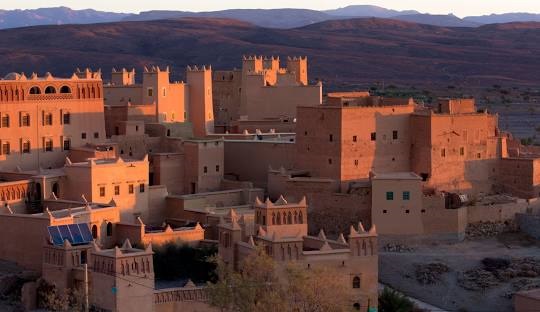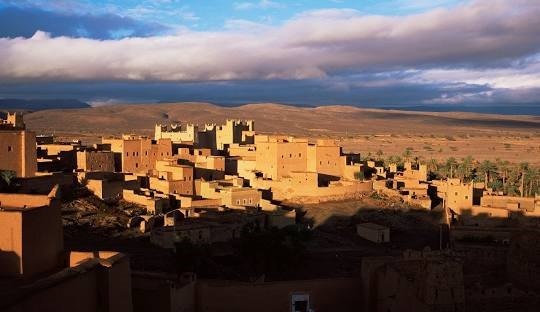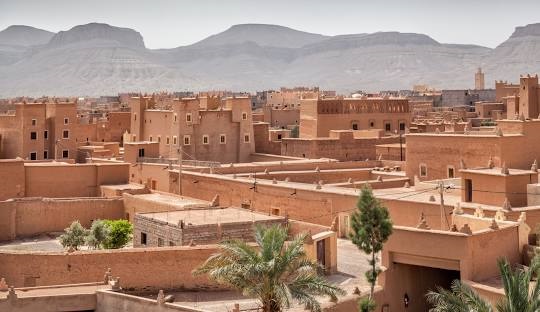Jbel Saghro, neighbouring Riad Nkob, is a striking mountain range in southeastern Morocco, situated between the High Atlas Mountains to the north and the expansive Sahara desert to the south. This unique geographical location makes Jbel Saghro a place of dramatic contrasts, with its rugged landscapes offering a stark beauty that has captivated travelers, photographers, and adventurers for generations.
Jbel Saghro
The region’s unique geology, diverse ecosystems, and rich cultural history make it a fascinating destination for those looking to explore one of Morocco’s less-traveled areas. Jbel Saghro is part of the Anti-Atlas range, which extends across southern Morocco. The mountains are relatively low in elevation compared to the High Atlas, with the highest peak, Amalou n’Mansour, reaching an altitude of about 2,712 meters.
The range is characterized by its volcanic origin, with much of the landscape shaped by ancient lava flows and basaltic formations. This history is evident in the dark, craggy rock formations that dominate the scenery, contrasting sharply with the bright blue skies and the occasional green valleys. The geology of Jbel Saghro is complex, consisting mainly of Precambrian and Paleozoic rocks, with significant volcanic activity having shaped much of the terrain.
The rugged mountains are interspersed with deep gorges, steep cliffs, and broad plateaus, creating a diverse and challenging landscape. The valleys of Jbel Saghro are often dry riverbeds, which can become rushing torrents during rare but intense rainstorms. The region’s arid climate and dramatic terrain make it a natural barrier, separating the fertile plains of the Draa Valley to the south from the more temperate regions to the north.
The climate of Jbel Saghro is semi-arid, with hot summers and cold winters. The region experiences a significant temperature range between day and night, a characteristic typical of desert climates. In the summer, daytime temperatures can soar above 40°C, while in the winter, nighttime temperatures can drop below freezing, especially at higher elevations.
Rainfall is sparse and irregular, often occurring in short, intense bursts that can lead to flash flooding in the valleys and gorges. Despite the harsh conditions, the region supports a surprising variety of flora and fauna adapted to the arid environment. Jbel Saghro’s vegetation is typical of semi-arid environments, with hardy plants that can withstand the extreme temperatures and limited water supply.
The landscape is dotted with acacia trees, thorny shrubs, and a variety of cacti and succulents. In the spring, after the rare rains, the mountains can briefly bloom with wildflowers, adding a splash of color to the otherwise stark terrain. This fleeting display of life is a testament to the resilience of the plants that have adapted to survive in such a harsh environment.
The fauna of Jbel Saghro is equally adapted to the challenging conditions. The region is home to several species of reptiles, including lizards and snakes, which thrive in the hot, rocky landscape. Birds such as the desert lark, the Barbary partridge, and the occasional eagle or vulture can be spotted soaring above the cliffs and gorges.
Mammals are less common, but species such as the Barbary sheep and the fennec fox can occasionally be seen. These animals are highly adapted to the arid conditions, able to find food and water in an environment that seems inhospitable to most. Jbel Saghro has a rich cultural history, shaped by the Berber tribes who have inhabited the region for centuries.
The Aït Atta tribe is the most prominent in the area, known for their semi-nomadic lifestyle, herding goats and sheep across the mountains and valleys. The Aït Atta are renowned for their fierce independence and resilience, having resisted various invasions and occupations throughout history. Their culture is deeply connected to the land, with a profound respect for the natural environment that sustains their way of life.
Jbel Saghro is dotted with small villages and settlements, where traditional Berber architecture can be seen in the form of stone houses and fortified dwellings that blend seamlessly into the rocky landscape. These villages are often built near sources of water, such as springs or wells, which are vital for survival in this arid region.
The Aït Atta’s way of life is based on a deep knowledge of their environment, with generations of experience in managing scarce resources and living in harmony with the land. One of the most significant historical events in the region was the Battle of Bou Gafer in 1933, where the Aït Atta, under the leadership of their chief, Assou Oubasslam, fought against the French colonial forces.
The battle took place in the rugged terrain of Jbel Saghro, where the Aït Atta used their intimate knowledge of the landscape to their advantage. Despite being heavily outnumbered and outgunned, they managed to hold out for several weeks before finally surrendering. The battle is still remembered today as a symbol of Berber resistance and resilience.
In recent years, Jbel Saghro has become a popular destination for trekking and adventure tourism. The region’s rugged landscapes, dramatic scenery, and remote location make it an ideal destination for those seeking a challenging and off-the-beaten-path adventure. Several trekking routes cross the mountains, ranging from short day hikes to multi-day expeditions that take visitors deep into the heart of this remote region.
One of the most popular trekking routes is the Jbel Saghro traverse, a multi-day trek that crosses the range from north to south. This route takes trekkers through some of the most spectacular scenery in the region, including the dramatic Tizi n’Tazazert pass, the towering rock formations of Bab n’Ali, and the remote oasis of Igli.
Along the way, trekkers have the opportunity to visit traditional Berber villages, experience the local culture, and witness the stark beauty of the landscape up close. Trekking in Jbel Saghro is not without its challenges. The region’s remote location and harsh climate mean that trekkers need to be well-prepared and self-sufficient.
Water sources are scarce, and the rugged terrain can be demanding, requiring a good level of fitness and experience. However, for those willing to take on the challenge, the rewards are immense. The sense of isolation and solitude, the dramatic landscapes, and the chance to experience a way of life that has remained largely unchanged for centuries make trekking in Jbel Saghro a truly unique experience.
Jbel Saghro is a region of stark contrasts and rugged beauty, a place where the forces of nature have sculpted a landscape of dramatic peaks, deep gorges, and broad plateaus. Its unique geography and geology, combined with its rich cultural history and remote location, make it a fascinating destination for those seeking adventure and exploration.
Whether trekking through its rugged mountains, exploring its remote villages, or simply taking in the breathtaking scenery, Jbel Saghro offers a glimpse into a world that is both timeless and awe-inspiring. For those willing to venture off the beaten path, Jbel Saghro is a place where the spirit of adventure and the beauty of nature come together in perfect harmony.



